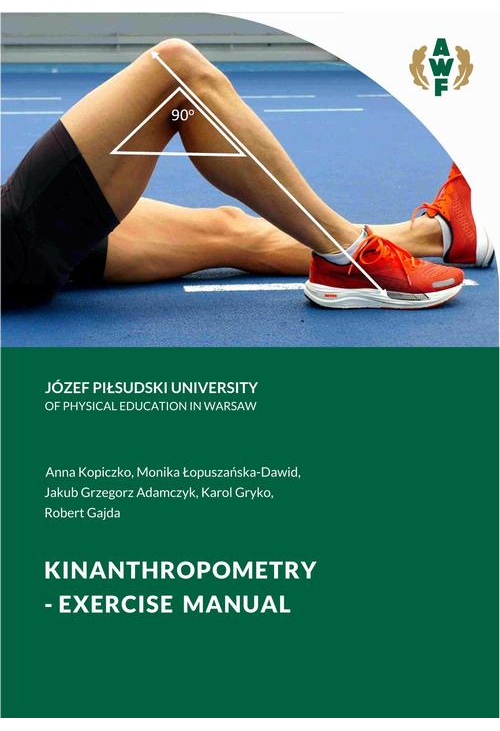
- -28%
ebook KINANTHROPOMETRY - EXERCISE MANUAL
Odkryj fascynujący świat kinan-thropometrii z naszą nowatorską publikacją "Kinanthropometry - Exercise Manual". Ten niezwykły przewodnik, będący efektem współpracy ekspertów takich jak Anna Kopiczko, Monika Łopuszańska-Dawid, Jakub Grzegorz Adamczyk, Karol Gryko oraz Robert Gajda, został wydany przez renomowane wydawnictwo AWF Warszawa w 2024 roku. Ta anglojęzyczna pozycja jest nieocenionym zasobem dla osób zainteresowanych analizą morfologicznych uwarunkowań umiejętności ruchowych, które stanowią przedmiot badań tej stosunkowo młodej dyscypliny naukowej.
Nazwa "kinan-thropometry" wywodzi się z greckich słów: kinein (poruszać się), anthropos (człowiek) oraz metrein (mierzyć). Ta publikacja jest materiałem pomocniczym dla prowadzenia zajęć praktycznych w dziedzinie sportu. Jej celem jest zapoznanie studentów z podstawami kinan-thropometrii jako nowego przedmiotu akademickiego oraz dostarczenie kompletnego zestawu metod referencyjnych do diagnozowania kinan-thropometrycznego.
Pomiarów zazwyczaj dokonuje się za pomocą metod antropometrycznych, a następnie analizuje je w kontekście efektów ludzkiej aktywności ruchowej. Kinan-thropometria zyskuje na popularności na całym świecie i jest wykorzystywana w wielu obszarach badawczych, szczególnie w kulturze fizycznej oraz naukach medycznych i zdrowotnych. Znajduje zastosowanie w takich dziedzinach jak ergonomia, żywienie, opieka zdrowotna czy prewencja urazów.
Celem kinan-thropometrii jest uzyskanie kompleksowego zrozumienia funkcjonowania ludzkiego organizmu poprzez pomiar jego wielkości, kształtu, proporcji oraz składu tkankowego w kontekście zdrowia, aktywności ruchowej i wydajności motorycznej. Analiza relacji między strukturą morfologiczną a efektami ruchowymi przyczynia się do optymalizacji treningu sportowców poprzez zmniejszenie ryzyka kontuzji oraz opracowywanie odpowiednich strategii terapeutycznych.
Badania prowadzone na dzieciach otwierają dodatkowe możliwości identyfikacji ich potencjału sportowego we wczesnym stadium rozwoju, a jednoczesne monitorowanie zmian w grupach nie-sportowców i sportowców umożliwia określenie wpływu wczesnego treningu sportowego na przebieg dojrzewania i rozwoju. Część praktyczna przewodnika jest zorganizowana tak, aby była przydatna dla przyszłej pracy trenerskiej, niezależnych badań naukowych oraz prac dyplomowych na poziomie licencjackim, magisterskim czy doktorskim.
W każdej treści kładzie się nacisk na testy, protokoły i procedury, zbieranie danych, analizę oraz właściwą interpretację wyników. Zapraszamy do odkrycia bogactwa informacji zawartych w tej publikacji i wykorzystania ich we własnej pracy naukowej, badawczej lub trenerskiej. Kinanthropometry - Exercise Manual to nie tylko źródło wiedzy, ale także narzędzie do rozwijania umiejętności i eksploracji nowych możliwości w dziedzinie analizy ruchu ludzkiego. Pobierz swój egzemplarz w formacie PDF już dziś i zanurz się w świecie kinan-thropometrii!
Kup e-booka i czytaj na swoim urządzeniu mobilnym, tablecie lub komputerze. Oferujemy wydania elektroniczne w najpopularniejszym formacie cyfrowym - PDF. Znajdziesz u nas nie tylko specjalistyczną literaturę naukową, ale także bestsellery ebooki z różnych dziedzin życia i nauki. Odwiedź sklep z ebookami już teraz i ciesz się bogatym wyborem publikacji dostępnych na wyciągnięcie ręki!
Spis treści ebooka KINANTHROPOMETRY - EXERCISE MANUAL
INTRODUCTION1. BODY MEASUREMENTS IN KINANTHROPOMETRY
1.1. Measurement instruments
1.2. Measurement technique in kinanthropometry
1.3. Somatometry in sport
1.4. Cephalometry in sport
1.5. Kinanthropometry in Adapted Sport
2. BODY INDICATORS AND INDICES IN SPORTS
2.1. Indices of physique, body proportions, and muscularity
2.2. Indices of general fatness and fat distribution
2.3. Fat-Free Mass Index (FFMI) and Fat Mass Index (FMI)
3. BODY COMPOSITION METHODS
3.1. Assessment of body composition based on somatic and body density measurements
3.2. Bioelectrical Impedance Analysis
3.3. Densitometry
4. FUNCTIONAL TESTING METHODOLOGY
4.1. Diagnostics of muscle dystonia, flexibility, mobility, and movement patterns
4.2. Anti-rotation and balance tests
4.3. Selective functional movement assessment
4.4. Measurements of range of motion: goniometry
5. EVALUATION OF SYMMETRY AND ASYMMETRY IN SPORTS
6. KINANTHROPOMETRY & EXERCISE PHYSIOLOGY
6.1. Heart rate monitors
6.2. Causes of artifacts on HRMs
6.3. Modern HRMs with ECG recording function and the procedure in case of detecting ,,arrhythmia\" on HRM\'s
6.4. Interpretation of HR measurements in training and post-exercise recovery
6.5. Heart Rate Variability (HRV)
7. STATISTICAL METHODS IN KINANTHROPOMETRY
7.1. Preparation of data for statistical processing
7.2. Statistical analysis
7.3. Tabular and/or graphical representation of results
REFERENCES
ABOUT THE AUTHORS
Szczegóły ebooka KINANTHROPOMETRY - EXERCISE MANUAL
- Wydawca:
- AWF Warszawa
- Rok wydania:
- 2024
- Typ publikacji:
- Ebook
- Język:
- angielski
- Format:
- Liczba stron:
- 144
- Miejsce wydania:
- Warszawa
Recenzje ebooka KINANTHROPOMETRY - EXERCISE MANUAL
-
Reviews (0)

Na jakich urządzeniach mogę czytać ebooki?
- -28%















@CUSTOMER_NAME@
@COMMENT_TITLE@
@COMMENT_COMMENT@